Back to Don's Maps
Back to Venus figures from the Stone Age
The Venus of La Poire
La Poire is a figurine of mammoth ivory of which only the corpulent torso survives, found in 1892 in the 'Grotte du Pape' at Brassempouy in the Department of Les Landes and now in the Musée St. Germain-en-Laye. The name 'Venus' for this figurine was subsequently adopted by Édouard Piette (1827-1906). She was originally nicknamed la poire - 'the pear' - on account of her shape. For Piette, the name 'Venus' may have come to mind in this particular instance because of the emphatic treatment of the vulva's labia and the prominent, slightly protruding pubic area, which he tastefully refers to as 'le mont de Vénus' - the mound of Venus (or mons pubis). 'Venus' has since become the collective term used to identify all obese Palaeolithic statuettes of women.
Text above adapted from http://arthistoryresources.net/willendorf/willendorfname.html
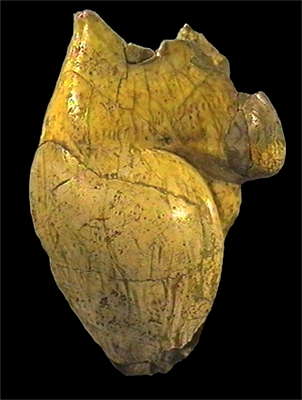
The name 'Venus' was adopted by Édouard Piette (1827-1906), who used it to describe this mammoth ivory figurine, of which only the corpulent torso survives, found in 1892 in the 'Grotte du Pape' at Brassempouy in the Department of Les Landes and now in the Musée St. Germain-en-Laye.
The figure has massive thighs, and a pendulous, pointed abdomen. On the lower abdomen and thighs we can see two rows of notches, which have been interpreted as tattoos.
Height 79 mm.
Photo and text adapted from: http://www.nihilum.republika.pl/W_Brassempouy_02.htm
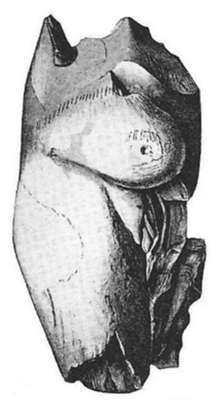
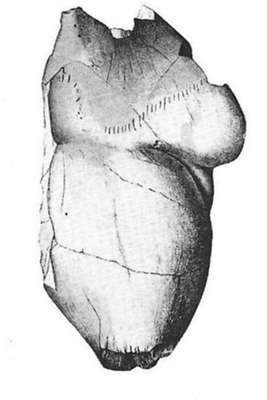
Two drawings by Piette of the Poire venus, showing a three quarter view.
Photo: Marshack (1972) (after Piette)
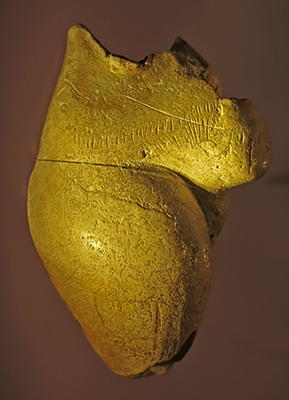
This is a very well made museum quality facsimile. Many of the cracks and scratches of the original have been inevitably removed in the process.
However, in this version we can see much more clearly the two rows of 'tattoos'.
Photo: Don Hitchcock 2014
Source: La Maison de la Dame, Brassempouy Museum
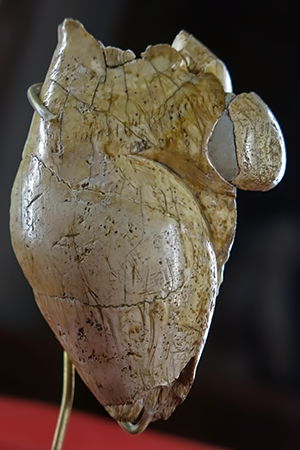
La Poire
27 000 BP, Gravettian.
Dimensions: 43 mm x 25 mm x 26 mm.
Photo: Don Hitchcock 2015
Catalog: MAN47333
Text: http://www.photo.rmn.fr/cf/
Source: Original, la salle Piette, Musée d'Archeologie Nationale et Domaine, St-Germain-en-Laye
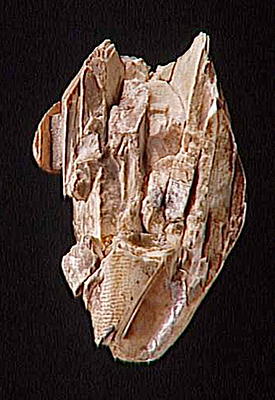
La Poire, from the other side.
Photo: http://www.photo.rmn.fr/archive/97-014822-2C6NU0SXX33D.html
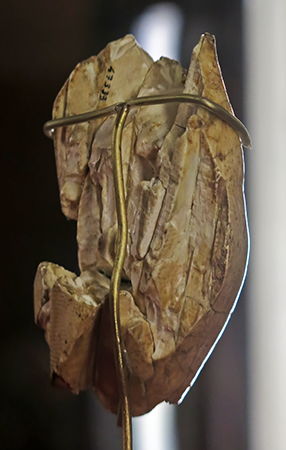
La Poire, from the other side.
Photo: Don Hitchcock 2015
Source: Original, la salle Piette, Musée d'Archeologie Nationale et Domaine, St-Germain-en-Laye
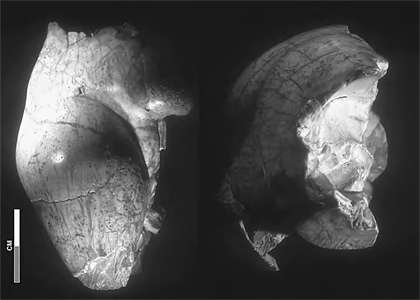
Profile and top views of the mammoth-ivory figurine fragment known as La Poire (the pear), the only Brassempouy figurine that Piette labelled a Venus: La Vénus de Brassempouy.
This name was almost certainly a reference to Saartjie Baartman, the so-called Hottentot Venus. The prominent mons venus is visible in profile at left.
Found during preparatory digging in the days immediately preceding the AFAS excursion of 1892, the damage wrought by Dubalen’s excavators is evident at right.
Photo and text: R. White, White (2006)
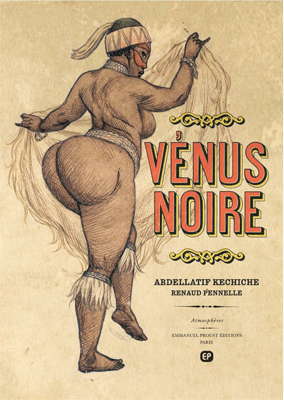
Saartjie Baartman - The Hottentot Venus, probably the reason that 'la Poire' was called la Vénus de Brassempouy by Piette.
Sarah "Saartjie" Baartman (before 1790 – 29 December 1815) (also spelled Bartman, Bartmann, Baartmen) was the most famous of at least two Khoikhoi women who were exhibited as freak show attractions in 19th century Europe under the name Hottentot Venus—"Hottentot" as the then-current name for the Khoi people, now considered an offensive term, and "Venus" in reference to the Roman goddess of love.
Baartman was a slave of Dutch farmers near Cape Town when Hendrick Cezar, the brother of her slave owner, suggested that she travel to England for exhibition, promising her that she would become wealthy.
Baartman was exhibited around Britain, entertaining people by showing what were thought of as highly unusual bodily features. She had large buttocks (steatopygia) and the elongated labia of some Khoisan women. To quote historian of science Stephen Jay Gould, "The labia minora, or inner lips, of the ordinary female genitalia are greatly enlarged in Khoi-San women, and may hang down three or four inches below the vulva when women stand, thus giving the impression of a separate and enveloping curtain of skin". Baartman never allowed this trait to be exhibited while she was alive, and an account of her appearance in London in 1810 makes it clear that she was wearing a garment, although apparently a tight-fitting one.
She died on 29 December 1815 of an indetermined inflammatory ailment, possibly smallpox, while other sources suggest she contracted syphilis, or pneumonia.
Photo: http://berichtenuithetverleden.wordpress.com/2010/12/28/saartjie-baartman-1789-1815-de-hottentot-venus/
Text: Adapted from Wikipedia

This is a reconstruction of what the Poire Venus may have looked like.
Ralph Frenken, another venus enthusiast, first alerted me to the presence of this venus, which we could find no other evidence of, in the book by Bataille (1989). It was identified there as the Venus of Sireuil, and at first I thought that it was another venus also found at Sireuil, as well as the famous one.
However we could find no reference to it, and could not work out why there was no mention of it, when it was such a superbly finished work - perhaps it was a fake?
I put the Bataille venus images on my web page, with a request for identification, and not long after, a very knowledgeable prehistorian, Eric Le Brun, who has an excellent prehistory blog at http://elebrun.canalblog.com/, enhanced by his scientifically accurate and beautiful drawings, identified it as a reconstruction of La Poire.
Photo: Bataille (1989) (note that Bataille wrongly identifies it as the Sireuil Venus)
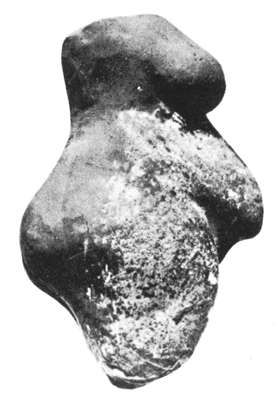
The side view of the reconstruction of La Poire. Note the protruding abdomen.
Photo:
Bataille (1989)

Advertisement for a facsimile of a recreated Poire Venus.
Photo: unknown, possibly a now missing page of http://www.paleoscope.com/
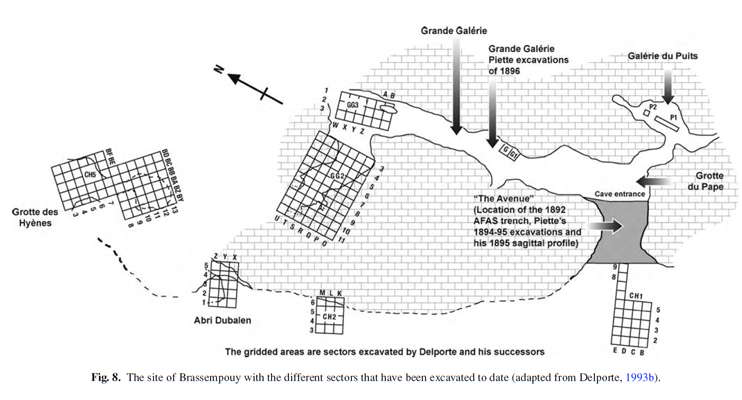
The site of Brassempouy with the different sectors that have been excavated to date (adapted from Delporte, 1993b).
Photo and text: R. White, White (2006)
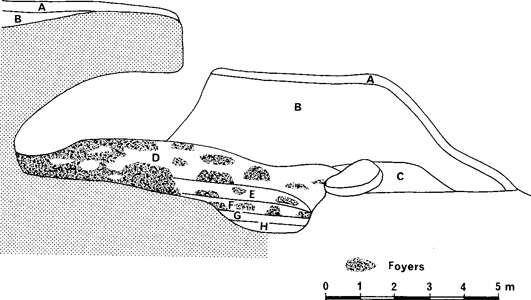
Piette’s (1895) sagittal profile along 'The Avenue.'
A: Humic layer,
B: Yellow silt (2 to 2.5 m thick), which Piette saw as a continuation of the Magdalenian layers inside the cave.
C: Yellow blocky layer (90 cm thick) containing Solutrean pieces; restricted to the zone distal to 'The Avenue.'
D,E,F (taken together, from 1 to 2.5 m thick) : Yellow clay containing a series of layers attributed at the time to the Magdalenian, the Solutrean and the Mousterian.
G: Sterile clay (25 cm thick).
H: Sterile gravels (30 cm thick).
Photo and text: R. White, White (2006)
References
- Bataille, G., 1989: The tears of Eros, City lights books, (translated from Les larmes d'Éros, 1961)
- Delporte, H., 1993a: Gravettian Female Figurines: A Regional Survey, in Knecht, H., Pike-Tay, A., and White, R. (eds.), Before Lascaux, The Complex Record of the Early Upper Paleolithic, CRC Press, Boca Raton, pp. 243–257.
- Delporte, H., 1993b: L’image de la femme dans l’art préhistorique, Picard, Paris.
- Marshack, A., 1972: The Roots of Civilization: the Cognitive Beginning of Man’s First Art, Symbol and Notation New York, McGraw-Hill
- White, R., 2006: The Women of Brassempouy: A Century of Research and Interpretation, Journal of Archaeological Method and Theory, Vol. 13, No. 4, December 2006